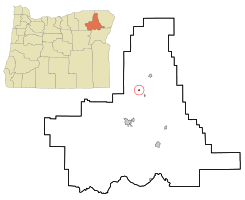Summerville, Oregon facts for kids
Quick facts for kids
Summerville, Oregon
|
|
|---|---|

(former) Dry Creek School in Summerville
|
|

Location in Oregon
|
|
| Country | United States |
| State | Oregon |
| County | Union |
| Incorporated | 1885 |
| Area | |
| • Total | 0.26 sq mi (0.68 km2) |
| • Land | 0.26 sq mi (0.68 km2) |
| • Water | 0.00 sq mi (0.00 km2) |
| Elevation | 2,713 ft (827 m) |
| Population
(2020)
|
|
| • Total | 119 |
| • Density | 450.76/sq mi (173.78/km2) |
| Time zone | UTC-8 (Pacific) |
| • Summer (DST) | UTC-7 (Pacific) |
| ZIP code |
97876
|
| Area code(s) | 541 |
| FIPS code | 41-70850 |
| GNIS feature ID | 2413348 |
Summerville is a city in Union County, Oregon, United States. The population was 135 at the 2010 census.
Contents
History
Summerville was platted on September 20, 1873, along Ruckle Road by William H. Patten. Patten had a freight depot along Ruckles Road, only the second road over the Blue Mountains, which was a popular route over the Blue Mountains until it washed out in 1884. Speculators and investors then moved to Elgin, Oregon. An 1888 Sanborn map, the first of four of the city, shows an opera hall, bank, livery, drugstore, as well as other stores. In 1888, half of the main street buildings were destroyed in a fire, but were rebuilt soon after. As the town was already in a sharp commercial decline by 1910, buildings that were destroyed after then were not replaced. In 1890, the population was 280 people.
Geography
Summerville lies in the northern Grande Ronde Valley about 4 miles (6 km) northwest of Imbler along Summerville Road. Oregon Route 82 passes through Imbler, between La Grande to the southwest and Elgin to the northeast. Mill Creek, a tributary of Willow Creek, which itself is a tributary of the Grande Ronde River, flows through Summerville.
According to the United States Census Bureau, the town has a total area of 0.26 square miles (0.67 km2), all of it land.
Climate
This region experiences warm (but not hot) and dry summers, with no average monthly temperatures above 71.6 °F (22.0 °C). According to the Köppen Climate Classification system, Summerville has a warm-summer Mediterranean climate, abbreviated "Csb" on climate maps.
Demographics
| Historical population | |||
|---|---|---|---|
| Census | Pop. | %± | |
| 1890 | 280 | — | |
| 1900 | 184 | −34.3% | |
| 1910 | 237 | 28.8% | |
| 1920 | 116 | −51.1% | |
| 1930 | 116 | 0.0% | |
| 1940 | 80 | −31.0% | |
| 1950 | 73 | −8.7% | |
| 1960 | 76 | 4.1% | |
| 1970 | 76 | 0.0% | |
| 1980 | 143 | 88.2% | |
| 1990 | 111 | −22.4% | |
| 2000 | 117 | 5.4% | |
| 2010 | 135 | 15.4% | |
| 2020 | 119 | −11.9% | |
| U.S. Decennial Census | |||
2010 census
As of the 2010 census, there were 135 people, 45 households, and 38 families residing in the town. The population density was 519.2 inhabitants per square mile (200.5/km2). There were 50 housing units at an average density of 192.3 per square mile (74.2/km2). The racial makeup of the town was 97.0% White, 0.7% from other races, and 2.2% from two or more races. Hispanic or Latino of any race were 2.2% of the population.
There were 45 households, of which 53.3% had children under the age of 18 living with them, 64.4% were married couples living together, 13.3% had a female householder with no husband present, 6.7% had a male householder with no wife present, and 15.6% were non-families. 15.6% of all households were made up of individuals, and 8.9% had someone living alone who was 65 years of age or older. The average household size was 3.00 and the average family size was 3.26.
The median age in the town was 32.4 years. 37% of residents were under the age of 18; 3.7% were between the ages of 18 and 24; 27.3% were from 25 to 44; 18.5% were from 45 to 64; and 13.3% were 65 years of age or older. The gender makeup of the town was 53.3% male and 46.7% female.
See also
 In Spanish: Summerville (Oregón) para niños
In Spanish: Summerville (Oregón) para niños


